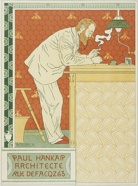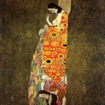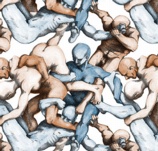

There are ten classes of patterns, each with a particular function, that make up the entire physical world — natural and human-made — at all scales:
A pattern can also be a model or mold intended to be copied.
Pattern comes to us from pater, Latin for father, and shares this origin with patron, paternal, and patriarchal. The Latin patronus means defender, protector, lord, or master. What pattern shares with each of these words is the notion of a role model. A pattern presents an idea that is highly worthy of imitation. Indeed imitation is so essential to pattern that it can be found in every example.
Examples:

Iranian, Persian, Fragment with Printed Lions, 10-11th
century, cotton, other fibers, 17 3/4 x 39 inches (45.1 x 99.1
cm), Metropolitan Museum of Art, NY. See fragment.

Turkey, Brusa, Brocaded Panel Fragment, 16th or 17th
century?, silk, 49 1/2 x 26 1/8 inches (125.7 x 66.4 cm), Metropolitan
Museum of Art, NY.

England, 17th century, Charger of Charles II in the Boscobel Oak , c. 1685, lead-glazed earthenware with slip
decoration, diameter
17 inches (43.2 cm), Los Angeles County Museum of Art. This is
also an example of radial balance
in design.

William Morris (English, 1834-1896), Pink and Rose Wallpaper Design, c. 1890,
hand-block-printed wallpaper, 22 x 28 inches (55.9
x 71.1 cm), Metropolitan Museum of Art, NY. See Arts
and Crafts Movement.

Designed by William Morris (British, 1834-1896),
made/manufactured by Morris
and Company, Merton Abbey, England, Length of Printed Cotton, 19th-20th century,
cotton, 8 feet 7 1/2 x 38 1/4 inches (262.9 x 97.2 cm), Metropolitan
Museum of Art, NY. See Arts
and Crafts Movement.

United States, Pennsylvania, Quilt, c. 1870-80, traditional "log cabin" pattern,
Pineapple variation, wool and cotton, 88 x 88 inches (223.5 x
223.5 cm), Los Angeles County Museum of Art. This is also an
example of a gridded or
rectilinear design.

United States, Pennsylvania, ’Contained’ Crazy Quilt, c. 1880, quilted printed cotton, 80 1/8 x 80 inches (203.52 x 203.2 cm), Los Angeles County Museum of Art.

Adolphe Crespin (Belgium, 1859-1944), Poster for ’Paul Hankar, Architect’, 1897, color lithograph, 15 1/2 x 11 1/8 inches (40 x 29 cm), Los Angeles County Museum of Art. See architect and poster.

Gustav Klimt (Austrian, 1862-1918), Hope, II, 1907-08, oil,
gold, and platinum on canvas,
43 1/2 x 43 1/2 inches, (110.5 x 110.5 cm), Museum of Modern
Art, NY. See Art
Nouveau, Austrian art, portrait, and secession.

Fernand Léger (French, 1881-1955),
Woman in Red and Green, 1914, oil
on canvas, 100 x 81 cm,
Georges Pompidou Center, Paris. See Cubism.

United States, Los Angeles, World War I Fundraiser Quilt, c. 1918, pieced and quilted cotton with signatures and drawings in pencil and colored inks, 75 x 60 inches (190.5 x 152.4 cm), Los Angeles County Museum of Art.

Sir Eduardo Paolozzi (English, 1924-2005), from "Moonstrips Empire News", [no
title], 1967, screenprint
on paper, image: 38.0 x 25.5 cm, Tate
Gallery, London. This is a set of patterns made entirely with
a motif of circles.

Marian Bantjes (Canadian, contemporary), Struggle, 2004, digital composite, collection of the artist. If you visit Ms Bantjes' site, be sure to peruse her other patterns and paintings. This tangle of nudes is a tessellation.
Also see brindled, egg-and-dart, épure, feather, fractal, French curve, harmonic sequence, interdisciplinary, kaleidoscope, moiré, monotony, music, obsession, paradigm, piebald, rhythm, tartan, tessellation, tradition, and variegated.
https://inform.quest/_art